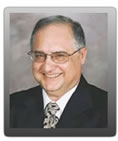Dr. Saba Presents the Keynote for the Distance Education Track of the University Professional and Continuing Education Conference

Dr. Farhad (Fred) Saba, Founder and Editor, Distance-Educator.com and Professor Emeritus of Educational Tecnology, San Diego State University
Dr. Farhad (Fred) Saba, Founder and Editor of Distance-Educator.com in his keynote presentation to the Distance Education track of the conference said” Distance education, employed in a systems approach to research, development and implementation offers a unique opportunity to increase access, flexibility and learning achievement while decreasing costs.” He continued that the current one-size-fits all system of higher education that served us well in the 20th century must be supplanted with a system that can provide differential responses to learners based on their individual differences.”
The majority of participants in the well attended session seemed to agree with this radical approach as it was evident in their approving nodes.
The cost of higher education is increasing because we have used very expensive technology to do exactly the same as we did in the industrial system of education in the emerging post-industrial era. The post industrial system of education, Dr. Saba asserted, requires that learners be allowed to exercise their autonomy in a dynamic system of teaching and learning where this autonomy is balanced with required structure by an instructor. Such balance, however, is different for each individual learner and the learning management system of the future should be designed with this important dynamic between the learner and the instructor in mind.
Dr. Saba, continued by presenting the steps that each institution can take to implement a dynamic systems model of management as well as instructional design that is suitable for their particular situation. Developed in the 1950s at MIT, System Dynamics is a branch of general system theory that specializes in understanding how various components in an organization, such as, management practices, instructional design, learner autonomy, and instructor control affect each other and are affected by each over a period of time. Although predicting the future is very difficult if not impossible, System Dynamics provides each individual institution to simulate future scenarios to avoid impending pitfalls and problems.
For considering a System Dynamics approach for future planning in your organization contact Dr. Saba at saba@distance-educator.com







